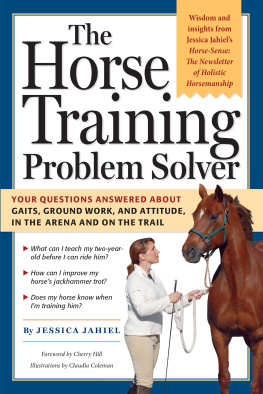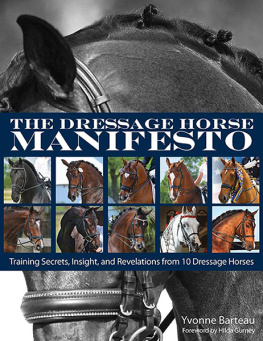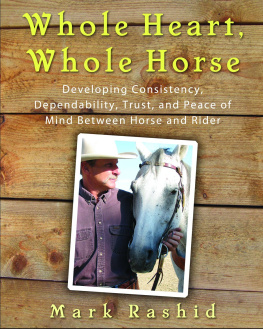The Horse Behavior Problem Solver

The Horse Behavior Problem Solver
YOUR QUESTIONS ANSWERED ABOUT
HOW HORSES THINK, LEARN, AND REACT
JESSICA JAHIEL
Illustrations by Claudia Coleman

The mission of Storey Publishing is to serve our customers by
publishing practical information that encourages
personal independence in harmony with the environment.
Edited by Deborah Burns
Art direction by Lisa Clark and Meredith Maker
Cover design by Kent Lew
Cover photograph Adam Jahiel
Text design and production by Cynthia McFarland
Indexed by Susan Olason
2004 by Jessica Jahiel
All rights reserved. No part of this book may be reproduced without written permission from the publisher, except by a reviewer who may quote brief passages or reproduce illustrations in a review with appropriate credits; nor may any part of this book be reproduced, stored in a retrieval system, or transmitted in any form or by any means electronic, mechanical, photocopying, recording, or other without written permission from the publisher.
The information in this book is true and complete to the best of our knowledge. All recommendations are made without guarantee on the part of the author or Storey Publishing. The author and publisher disclaim any liability in connection with the use of this information. For additional information please contact Storey Publishing, 210 MASS MoCA Way, North Adams, MA 01247.
Storey books are available for special premium and promotional uses and for customized editions. For further information, please call 1-800-793-9396.
Printed in the United States by Versa Press
20 19 18 17 16 15 14 13 12 11 10 9
LIBRARY OF CONGRESS CATALOGING-IN-PUBLICATION DATA
Jahiel, Jessica.
The horse behavior problem solver : your questions answered about how horses think,
learn, and react / Jessica Jahiel.
p. cm.
Includes bibliographical references and index.
ISBN 978-1-58017-525-8 (alk. paper)
ISBN 978-1-58017-524-1 (pbk. : alk.paper)
1. HorsesBehaviorMiscellanea. 2. HorsemanshipMiscellanea.
I. Title.
SF281 .J35 2004
636.10835dc22
2003021733
ACKNOWLEDGMENTS
No book is ever the creation of a single individual.
In this case, several people (and one particular group of people)
stand out for their special contributions:
Madelyn Larsen, agent and friend,
who found the ideal publisher for this book.
Deb Burns, Lisa Clark, Cynthia McFarland, and Ilona Sherratt,
the Storey dream team that gave the book its form.
Claudia Coleman, the extraordinary artist who created the detailed,
accurate, and absolutely charming illustrations.
Karen Fletcher, Web Goddess, without whom the HORSE-SENSE
mailing list and website would never have become a reality.
Last but not least: the HORSE-SENSE readers who have been
asking questions and telling their stories over the last eight years.
They are all constantly struggling with the difficulty
of matching theory to practice and applying horse management
concepts and general training principles to the individual animals
that they love, care for, and try so hard to understand.
Without them, this book would not exist.
DEDICATION
To the readers!
Horsemen around the world share certain qualities: a genuine affection for horses, an honest desire to learn, a willingness to listen to their horses, a willingness to look at the world around them and ask questions, and, above all, a willingness to give their horses the benefit of the doubt at all times.
Horsemanship doesnt mean learning lists and memorizing the right answers. It means watching, listening, reading, and learning. It means thinking about what youve learned, relating it to things youve seen and perhaps to things youve done, and applying your new understanding to your daily interactions with horses. Horsemanship means keeping your interest and curiosity alive, taking joy in learning and discovery, and always striving to learn more.
My goal is to help you understand how to figure things out for yourself by helping you to understand your horses. Most behavior problems in horses are nothing more or less than horses reacting to something in their environment. Most problems between humans and horses are the result of human actions actions of a human involved in the present situation or in the past. Either way, the person who is in the best position to analyze and solve the problem is the current human in the horses life you!
My overall ambition, in my writing as well as in my clinics, has always been to enable horses and riders to understand each other better and enjoy each other more. Life is too short for any of us to make all the possible mistakes and discoveries on our own. Its essential for us to learn from other peoples experiences and thats what this book is all about.

FOREWORD
IN PAST CENTURIES, directions on how to partner with horses were few and far between. Horses had a purpose to serve us and we needed them to do so without complaint. Whether laboring in the fields, carrying soldiers to battle, or serving as transportation, equines were seen as utilitarian in nature.
But todays horses are so much more. Yes, some still toil for humankind, but today its more of a partnership. Remote farms often find horses the ideal workmates. They protect and serve cities working with mounted police, and in the wilderness on park patrol. They partner with us in sport, from the racetrack to international Olympic events. They serve as friend, as mentor, as psychologist, and soulmate. For many of us, horses are our first love.
We owe it to them, then, to become educated, to find that manual that helps us understand the wonderful possibilities that exist between horse and rider. Jessica Jahiel has masterfully created one such book. In these pages, she examines our training and riding relationships, and provides valuable insight on how to solve the challenges that inevitably come our way.
So read on. And remember that in the chapters of your own horse life, the training issues you solve become footnotes on your way to a true union.
MOIRA C. HARRIS
Editor, Horse Illustrated

PREFACE
Why is my horse doing this, and what can I do about it?
DURING THE THIRTY-PLUS YEARS since I began teaching riders and horse owners to understand their horses better, Ive seen an encouraging trend: Horse owners are learning to ask much better questions. Instead of, Is there a gadget/drug/punishment that will make my horse stop doing this? todays horse owners are asking, Why is my horse doing this, and what can I do about it? The difference is huge and positive.
Even those who still think in terms of punishing their horses misbehavior by mechanical or chemical means are often happy to find that all they really need is a greater awareness of their horses feelings and a deeper understanding of the reasons behind their horses actions. With very few exceptions, horse misbehavior is either normal horse behavior misinterpreted by humans, or behavior developed by the horses in response to mishandling by humans.
Next page









